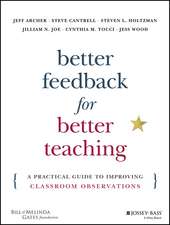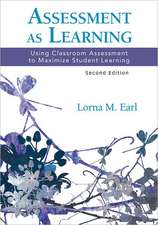The Three-Minute Classroom Walk-Through: Changing School Supervisory Practice One Teacher at a Time
Editat de Carolyn J. Downey, Betty E. Steffy-English, Fenwick W. English, Larry E. Frase, William K. Postonen Limba Engleză Paperback – 10 iun 2004
| Toate formatele și edițiile | Preț | Express |
|---|---|---|
| Paperback (1) | 273.84 lei 3-5 săpt. | +23.05 lei 6-12 zile |
| SAGE Publications – 10 iun 2004 | 273.84 lei 3-5 săpt. | +23.05 lei 6-12 zile |
| Hardback (1) | 540.44 lei 6-8 săpt. | |
| SAGE Publications – 23 iun 2004 | 540.44 lei 6-8 săpt. |
Preț: 273.84 lei
Nou
Puncte Express: 411
Preț estimativ în valută:
52.40€ • 54.60$ • 43.39£
52.40€ • 54.60$ • 43.39£
Carte disponibilă
Livrare economică 13-27 martie
Livrare express 26 februarie-04 martie pentru 33.04 lei
Preluare comenzi: 021 569.72.76
Specificații
ISBN-13: 9780761929673
ISBN-10: 0761929673
Pagini: 224
Ilustrații: Illustrations
Dimensiuni: 178 x 254 x 14 mm
Greutate: 0.46 kg
Ediția:First Edition
Editura: SAGE Publications
Colecția Corwin
Locul publicării:Thousand Oaks, United States
ISBN-10: 0761929673
Pagini: 224
Ilustrații: Illustrations
Dimensiuni: 178 x 254 x 14 mm
Greutate: 0.46 kg
Ediția:First Edition
Editura: SAGE Publications
Colecția Corwin
Locul publicării:Thousand Oaks, United States
Recenzii
"The book is easy to read and easy to understand. The information is practical and provides an excellent resource for administrators who are truly interested in improving instruction."
Cuprins
Preface
About the Authors
Dedication
1. Understanding the Rationale Underlying the Walk-Through and Reflective Practice Approach
What is the Downey Walk-Through?
Why Walk-Throughs?
The Evolution of the Downey Walk-Through Process
2. Conducting the Walk-Through Observation: A Five-Step Process
The Five-Step Observation Structure
Step 1: Student Orientation to Work
Step 2: Curricular Decision Points
Step 3: Instructional Decision Points
Step 4: "Walk the Walls" - Curricular and Instructional Decisions
Step 5: Safety and Health Issues
3. Moving Staff to Reflective Inquiry: Focusing on the Reflective Question and Conversation
How Do We Provide Direct Feedback?
The Note
A Better Approach-Discussion
Direct Feedback Statement and Conversation
How Do We Provide Indirect Opportunities for Reflective Inquiry?
How Do We Ask Reflective Questions and Carry On the Conversation?
How Do We Ask Reflective Questions and Carry On the Conversation?
The Reflective Conversation
4. Constructing a Taxonomy of Reflective Questions and Their Use in the Classroom Walk-
Through
The Novice/Apprentice
The Professional Teacher
The Expert Teacher
Limitations of the Taxonomy
5. Establishing Logistical Procedures for Implementing the Walk-Through Process
Finding the Time
Preparing Staff, Students, and Parents
Record Keeping
Board Policy to Support Walk-Throughs
6. Cultivating the Culture: Effectuating Change that Works
Lessons Learned About Change in Educational Cultures
Challenges and Barriers to Change
Deciding When to Intervene: The Marginal Teacher
Examples of Successful Implementation: Making the Walk-Through Process Work
Salinas Union High School District, California
Norman Public Schools, Norman, Oklahoma
Durham and Simco County School Boards, Ontario, Canada
Napa Valley Schools, Napa Valley, California
Shawnee Mission School District, Shawnee Mission, Kansas
Columbia-Brazoria Independent School District, Texas
San Leandro Unified School District, California
San Benito County, California, County Office of Education
Cultivating the Culture: A Final Word
7. Using the Walk-Through Process to Promote a Collaborative, Reflective Culture
Early History
Developmental Supervision and Mentoring
The Teacher as an Adult Learner
Promoting Development
8. Determining Whether Walk-Throughs Are the Right Stuff
Background and History of Management by Wandering Around
Why Are Both a Research and a Theory Base Needed Before Adopting An Innovation?
The MBWA Research Results
The Walk-Through with Reflective Question Research
9. Understanding the Walk-Through as a Discursive Practice
Examining the Dimensions of the Walk-Through
Changing the Discursive Practice of "Corrective" Supervision
Some Issues With the Model
A Pause to Consider Your Specific Situation
Troubleshooting Problems with the Downey Walk-Through
10. Linking the Walk-Through Process to a Model of Teacher Growth
Walk-Throughs and the Teacher Growth Model
The Model
Transformative Learning as it Relates to the Model
Organizational Learning and Transformation
Providing Feedback Conversation for Growth
Index
About the Authors
Dedication
1. Understanding the Rationale Underlying the Walk-Through and Reflective Practice Approach
What is the Downey Walk-Through?
Why Walk-Throughs?
The Evolution of the Downey Walk-Through Process
2. Conducting the Walk-Through Observation: A Five-Step Process
The Five-Step Observation Structure
Step 1: Student Orientation to Work
Step 2: Curricular Decision Points
Step 3: Instructional Decision Points
Step 4: "Walk the Walls" - Curricular and Instructional Decisions
Step 5: Safety and Health Issues
3. Moving Staff to Reflective Inquiry: Focusing on the Reflective Question and Conversation
How Do We Provide Direct Feedback?
The Note
A Better Approach-Discussion
Direct Feedback Statement and Conversation
How Do We Provide Indirect Opportunities for Reflective Inquiry?
How Do We Ask Reflective Questions and Carry On the Conversation?
How Do We Ask Reflective Questions and Carry On the Conversation?
The Reflective Conversation
4. Constructing a Taxonomy of Reflective Questions and Their Use in the Classroom Walk-
Through
The Novice/Apprentice
The Professional Teacher
The Expert Teacher
Limitations of the Taxonomy
5. Establishing Logistical Procedures for Implementing the Walk-Through Process
Finding the Time
Preparing Staff, Students, and Parents
Record Keeping
Board Policy to Support Walk-Throughs
6. Cultivating the Culture: Effectuating Change that Works
Lessons Learned About Change in Educational Cultures
Challenges and Barriers to Change
Deciding When to Intervene: The Marginal Teacher
Examples of Successful Implementation: Making the Walk-Through Process Work
Salinas Union High School District, California
Norman Public Schools, Norman, Oklahoma
Durham and Simco County School Boards, Ontario, Canada
Napa Valley Schools, Napa Valley, California
Shawnee Mission School District, Shawnee Mission, Kansas
Columbia-Brazoria Independent School District, Texas
San Leandro Unified School District, California
San Benito County, California, County Office of Education
Cultivating the Culture: A Final Word
7. Using the Walk-Through Process to Promote a Collaborative, Reflective Culture
Early History
Developmental Supervision and Mentoring
The Teacher as an Adult Learner
Promoting Development
8. Determining Whether Walk-Throughs Are the Right Stuff
Background and History of Management by Wandering Around
Why Are Both a Research and a Theory Base Needed Before Adopting An Innovation?
The MBWA Research Results
The Walk-Through with Reflective Question Research
9. Understanding the Walk-Through as a Discursive Practice
Examining the Dimensions of the Walk-Through
Changing the Discursive Practice of "Corrective" Supervision
Some Issues With the Model
A Pause to Consider Your Specific Situation
Troubleshooting Problems with the Downey Walk-Through
10. Linking the Walk-Through Process to a Model of Teacher Growth
Walk-Throughs and the Teacher Growth Model
The Model
Transformative Learning as it Relates to the Model
Organizational Learning and Transformation
Providing Feedback Conversation for Growth
Index
Notă biografică
Carolyn J. Downey is the creator of the walk-through process. She is currently an associate professor of educational leadership in the College of Education at San Diego State University. Downey was formerly the superintendent of schools for the Kyrene School District, Phoenix-Tempe, Arizona. She is a nationally recognized speaker and trainer and has assisted many of the nation's largest school systems in improving student achievement via the walk-through process. One such district is the Houston, Texas, Independent School District, which has been recognized by the Council of Great City Schools as one of the nation's four urban school systems closing the achievement gap. Downey is the originator of the 50 Ways to Close the Achievement Gap training program and publication. She received her MS from the University of Southern California and her EdD from Arizona State University.
Descriere
Change the entire school culture with this collaborative method of supervision!For years, the classic supervision model has frustrated both principals and teachers by fostering superior-subordinate relationships, focusing on teacher conformity rather than growth, or producing checklist data that are irrelevant to the curriculum. The Three-Minute Classroom Walk-Through offers a practical, time-saving alternative that impacts student achievement by cultivating self-reliant teachers who are continuously improving their practice.
This method answers principals' key questions:
This method answers principals' key questions:
- Is the work of my teachers aligned with district curriculum?
- Are my teachers using research-based "best practices"?
- Are they choosing the instructional strategies that will promote student achievement?













